When our Library first opened on 11 February 1856, the Argus commented that
No place that we have ever visited in Melbourne has so impressed us with a sense of the advance of civilisation in Victoria as the Public Library.
Our Library’s founder, Redmond Barry, had a vision of a Library as a “great emporium of learning and philosophy, of literature, science, and art.” 1
The magnificent Queen’s Hall Reading Room was a grand place for the bibliophile, researcher or casual reader, as it still is – beautifully renovated as The Ian Potter Queen’s Hall.
The Reading Room of the Melbourne Public Library [Queen’s Hall] 1866. S. Calvert (engraver); C Nettleton (photographer) IMP27/06/66/288; Ian Potter Queen’s Hall 2023.
The conundrum faced by Trustee President Redmond Barry and Chief Librarian Augustus Tulk, though, was how to share Library resources beyond the grand building.
The Library has always been a research collection, only purchasing single copies of books. Many of the books initially purchased for the Library were also very costly. Our copy of Gould’s Birds of Australia , for example, cost £140 (about $25,000 in 2023). As Redmond Barry pointed out, this precluded lending.
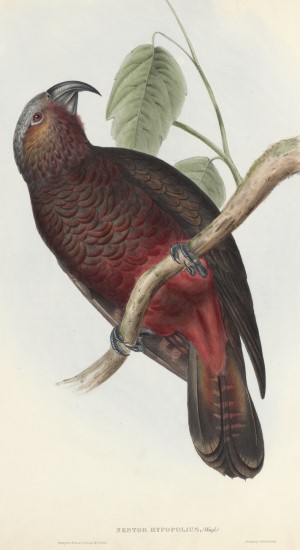
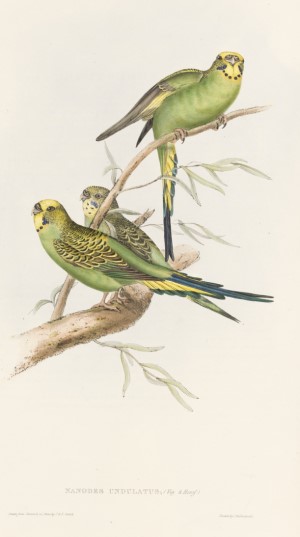

Images from Gould, J. (1848). The Birds of Australia : in seven volumes London: Published by the author. Nestor Hypolius; Nanodes Undulatus; Amadina Castanotis;
He noted that lending books would lead to the “frequent disappointment of applicants for a favourite or popular work not attainable because in use for several days” and commented on the need in a lending library for multiple copies of the same book to meet demand – “a reduplication of the same book prevents the acquisition of a like number of independent author’s works which we could not afford.”
He acknowledged though “the value of private or collective reading at home, and the saving of distance in bad or winter weather when going to or returning from the reading room” 2 and from the time the Library opened we have been looking for ways to connect everyone, across Victoria, with the Library.
The first initiative to take our Library to citizens who couldn’t come to the building was the establishment of a “Travelling Library”, or, officially, the Duplicate Book Loan System (DBLS). This service, claimed to be the first of its’ kind in the world, commenced in 1860, distributing duplicate collections of books to Public Libraries (such as existed at the time), Mechanics or Literary Institutions, Athenaeums or Municipal Corporations, for periods extending over 3, 4, or 6 months.
In 1881, after a clash of wills between Trustee President Redmond Barry and Premier Graham Berry, Thomas Bride was appointed Chief Librarian. Under his leadership the Library was extended with Barry Hall being built adjacent to Queen’s Hall, electric lighting was installed, (replacing the gas lamps), an efficient location and classification system was implemented and a card catalogue was created. In 1886, an inquiry desk was introduced and located in the centre of Queen’s Hall.
Thomas Bride felt, from early in his tenure, that a lending library that allowed for books to be borrowed would complement the reference collection.
If the aim of public libraries be not only to preserve but to diffuse knowledge as widely as possible, every facility should be afforded for the encouragement of healthy reading and it would seem that the system of lending libraries is a most potent agent to this end. 3
Bride pursued this project tenaciously, and finally, on 8 August 1892, the Lending Library opened. It was an immediate success. In 1893, there were 93,608 loans. Concerns about the safety of books were dispelled: during that year only six books were lost, of which four were paid for.
Originally the Lending Library occupied two temporary locations, the Swinburne Building basement on Little Lonsdale Street, and then in 1893 within the Great Exhibition Hall. In 1899 the Exhibition Hall was declared unsafe and demolished and replaced by temporary buildings which housed the Lending Library until it found a more permanent location, in 1908, in the Buvelot Gallery (now the Arts Library, Swinburne Building).
Interior of the Lending Library H4664 c. 1910 Buvelot Gallery became the Lending Library up to 1946 and is now the Arts Library
In 1946 the Lending Library moved to its final location, on the ground floor of the North East wing (now the Mr Tulk cafe).
In 1920, lending services were extended beyond the building, with the establishment of a Country Delivery Service. Books were packaged and sent to ‘remote’ patrons (initially ‘remote’ was 16 km from the GPO).
Patronage for the Lending Library dropped sharply with the progressive opening of Municipal Libraries, and the service came in for some sharp criticism in Meanjin
If it were a municipal library one would suspect that it would be in danger of losing its subsidy. Its catalogue can’t be consulted by members of the public. Its book selection is poor, and its appearance shabby…. There are strong grounds for holding that the library should not continue to provide a service which competes with various municipal libraries. 4
The Travelling Library, which had provided book collections for lending libraries for over a century, was greatly curtailed by 1965, and ceased soon after.
The Lending Library was finally closed in February 1971.
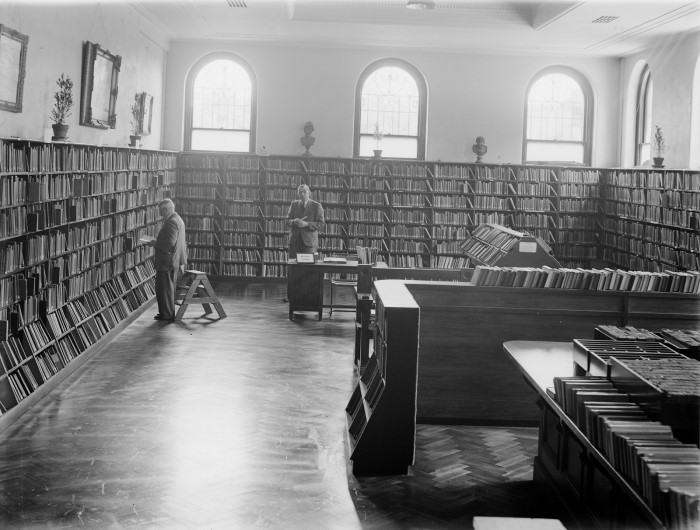
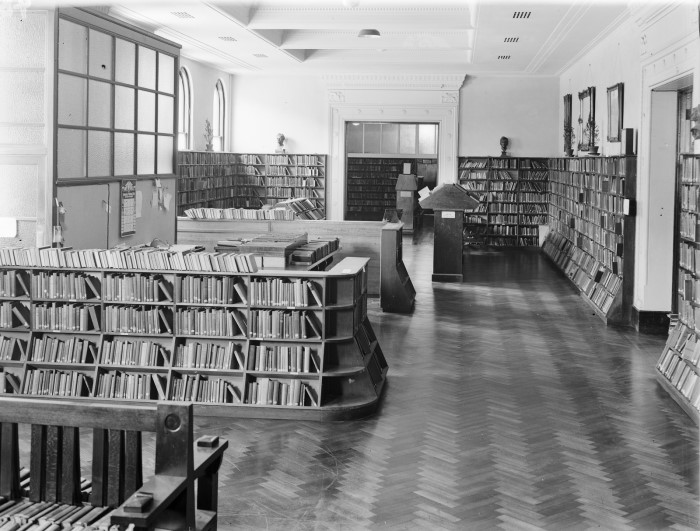
Interior view of the Lending Library c.1950 H40293 ; H40291 (currently Mr Tulk cafe).
The Country Borrowers Service remained popular up to the mid-1960s when the service had 7000 members, borrowing 62,000 books a year. By 1980 membership had dropped to only 70 borrowers and the service was closed in 1981.
The Library’s External Services section was established in February 1971 on the demise of the Lending Library. This section facilitated inter-library loans to municipal libraries and oversaw the Country Borrowers Service for its final decade.
Some items from the Lending Library were taken into the research collection and in September 1991, the Library held a great book sale of the remaining lending collection.
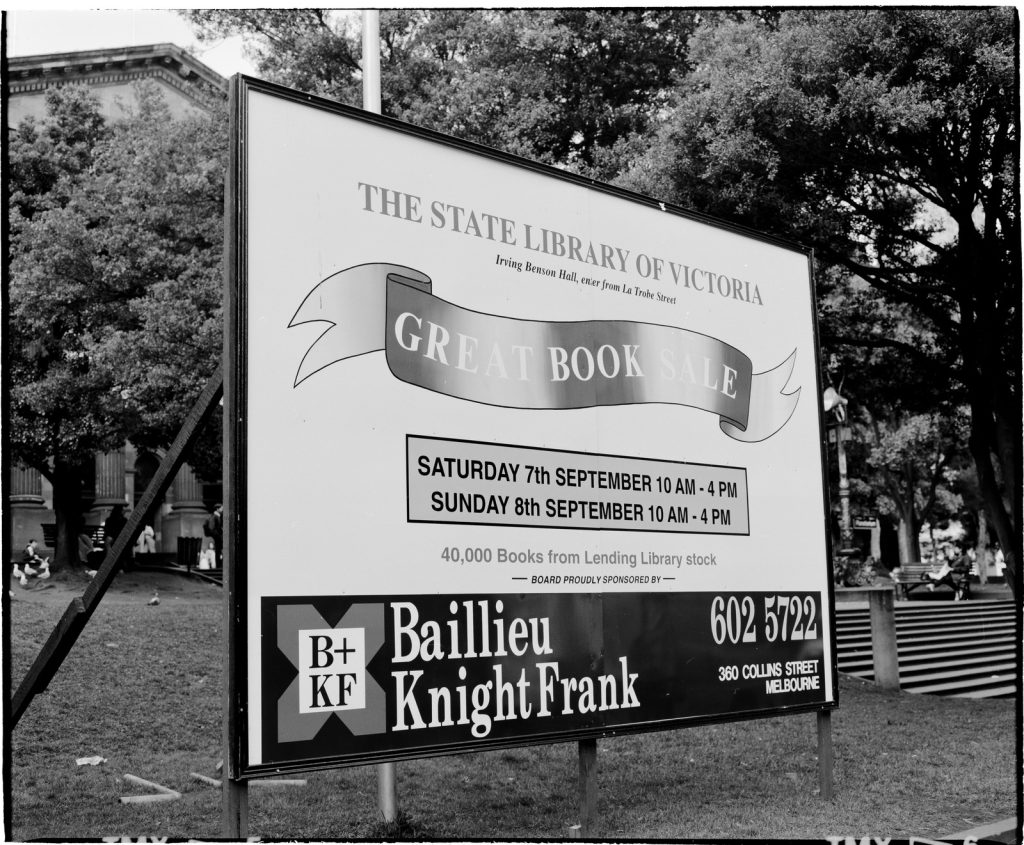

Flint, A. (1991). State Library of Victoria, Great Book Sale, 7-8 September 1991. H92.458/9 ; H92.458/10
Everything changed for all libraries (and the world) with the advent of the World Wide Web. In 1997 we launched our first website and the catalogue became available outside the Library.
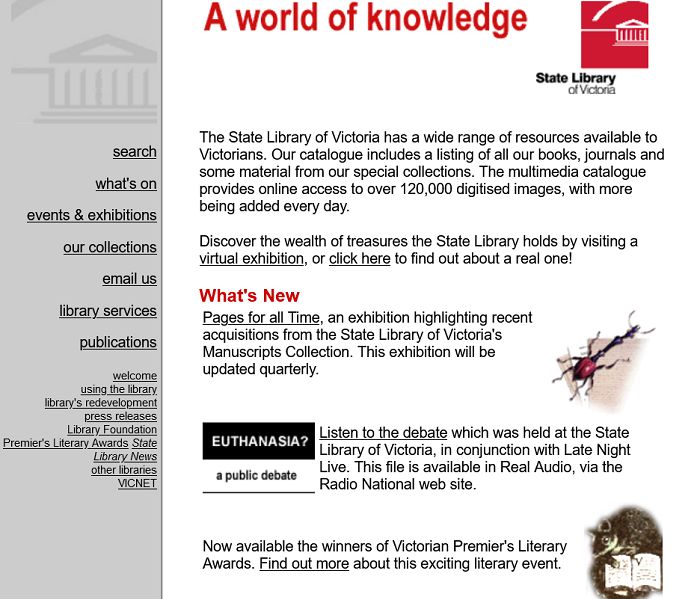
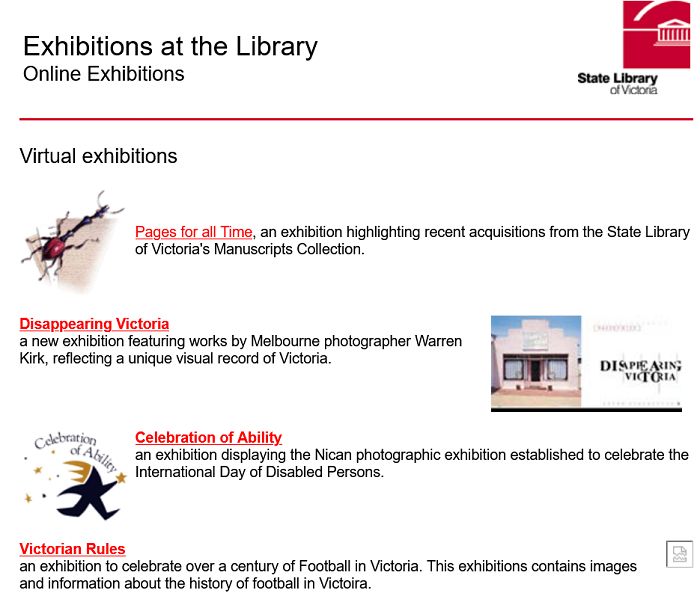
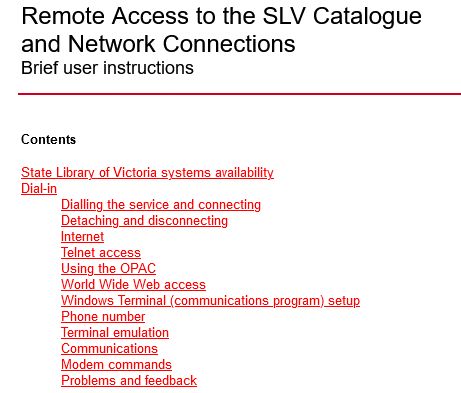
Our first website circa 1997-1999 with complex instructions for remote catalogue access!
Now our Library subscribes to a vast range of information databases of newspapers, journals, documents, music and video. These are available anywhere to any Victorian registered with the Library. We also have 80 guides helping you to get to the best sources of information for your research across many topics.
We have an online research service provided by our librarians, available anywhere, anytime. Many of the books we have purchased over the last decade are available as ebooks.
Our Library also has a very active digitising program, providing online access to many of our rare and fragile items for everyone. This includes print items and vast collections of images.
Ultimately the measures of any research library are resources of great depth, breadth and substance, available as widely as possible, and supported by expert advice, giving access to information, knowledge and culture. It is something the Library has always aimed to provide. We continue to pursue that aim now, in ways unimaginable in 1856.
References
- On lending libraries Redmond Barry Barry, R. (1877). Two papers read by Sir Redmond Barry, at the Conference of Librarians, held at The London Institution, October, 1877. London: G. Norman and Son, Printers. p. 13
- ibid p. 11
- Lending branch at the Public Library’, 24 April 1883, p. 6
- Dark Thoughts in the Library Meanjin June 1960 pp. 221-222


A Travelling Library book box from the State Library fetched up in Moe or nearby when the service ceased in 1965, abandoned by head office, and is now residing with a Mechanics’ Library book collection at the Old Gippstown Museum at Moe. I feel sure I took a photo of it, but it cannot be found, unfortunately.
I well remember the old lending library in what is now the Mr Tulk Café. When I came from Sydney to live and work in Dandenong in the 1960s, the town, as it then was, had no public library. I couldn’t believe it, having frequented municipal libraries in Sydney from a child. Despite its small size and limited collection, the old lending library off Lonsdale Street was an oasis of knowledge in the cultural desert of Melbourne’s outer suburbs in the 1960s and 70s..
A fascinating history.Thank you
I remember as a teenager in Ballarat going to the railway station on a regular basis to pick up my box of books sent up by the Lending Library, reading avidly, and then going back to the station to return them together with my next order. What a fantastic service for a family that couldn’t afford to buy books.